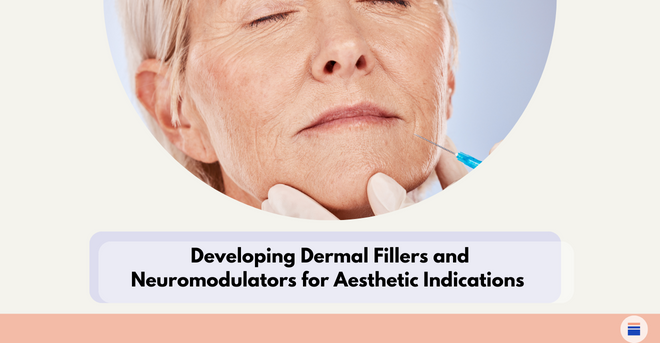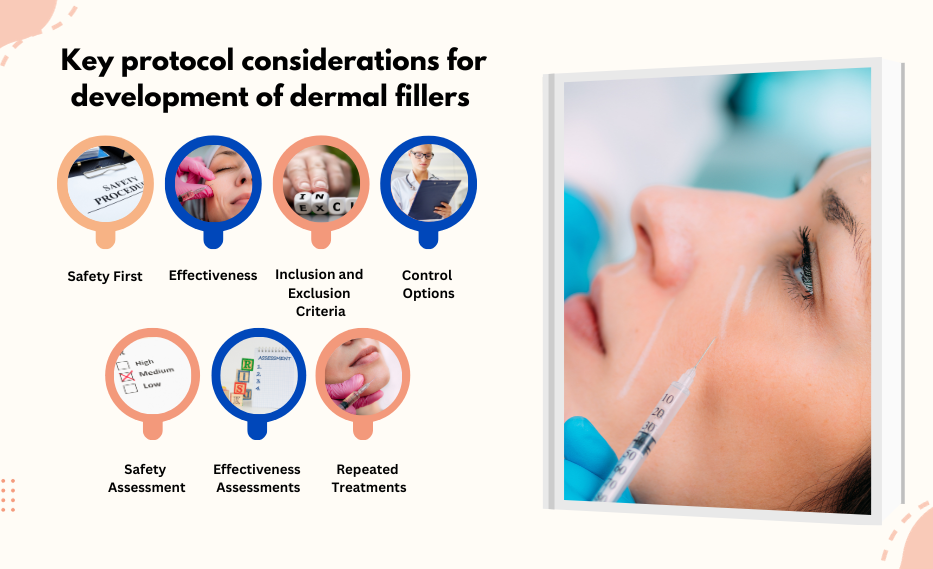Developing Dermal Fillers and Neuromodulators for Aesthetic Indications

Dermal fillers, also known as injectable implants, soft tissue fillers, or wrinkle fillers have been on the medical aesthetic market for over 30 years and have a variety of specific technological characteristics and indications. The successful conduct of a medical aesthetic clinical trial is dependent upon the development of an optimal study protocol, meticulous planning, and diligent implementation.
The key protocol considerations for development of dermal fillers are detailed below.

1. Safety First
- Safety is always a key area of focus during a trial execution. In the case of dermal fillers, the most concerning safety risk is visual impairment caused by unintentional intravascular injection. The increased number of AE reports led, in early 2021, to an FDA panel meeting to discuss significant additional safety considerations and recommendations for clinical development of dermal fillers.
2. Effectiveness
- The dermal fillers will be investigated differently depending on the existence and extent of previous clinical research efforts: For completely new filler products it is essential to demonstrate preliminary effectiveness and feasibility of planned studies.
- If a sponsor is developing a new indication for a previously approved dermal product, the inherited findings should be leveraged for optimal new clinical program.
- An assessment of the efficacy of the treatment as compared to a previously approved dermal filler requires study designs that will investigate non-inferiority or even superiority claims…
3. Inclusion and Exclusion Criteria
Defining the most appropriate study population is essential for a successful outcome of the trial.
Key Inclusion criteria considerations
- The key characteristics related to the aesthetic indication in focus: a) defined ranges for severity of aesthetic disorder, b) Using a validated clinician-reported outcome assessment tool to determine the severity and identify whether the patient meets all the criteria.
- Adequate representation of intended population: regulators have become increasingly sensitive to proper intended population representation, and it is recommended by the FDA that at least 20% of patients have dark skin types 4 to 6 and 10% with a skin type of 5 to 6 according to the Fitzpatrick Classification of Skin Types.
Key Exclusion criteria considerations
- Prior treatments: patients who have had recent treatments or concurrent treatments in the same physical region as the one studied in the trial would be excluded.
- Underlying conditions (and especially ophthalmic findings) may increase the safety risk and need to be carefully assessed by the investigator.
4. Control Options
When assessing the efficacy of a dermal filler, in a randomized controlled study choices of control are:
- No-treatment control
- Sham-treatment control
- Active comparator device
5. Safety Assessment
- Injection site reactions/treatment responses: They need to be very diligently tracked in a safety patient diary for at least 2 weeks and up to 4 weeks, after the application of the dermal filler.
- Documenting AEs: It is essential to conduct safety assessments throughout the clinical trial which includes closely recording and monitoring any adverse events (AEs).
- Indication-specific assessments: Assessments on mobility of the treated area should be included in the study protocol (for example lip movement for ability to speak, an assessment of smile, normal movement, and activity in the treatment area, etc.).
- Monitoring for visual impairment: Concern around blindness and stroke following dermal filler injections must be eliminated by adequate visual assessment during screening. Consenting only patients without relevant risk and monitoring for changes in visual function throughout the trial.
6. Effectiveness Assessments
The primary endpoint in a dermal filler study will be assessed by use of the validated ClinRO (Clinician Reported Outcomes). Regulators are recommending having a validated PRO as a co-primary and the data will be reported as a responder rate. The regulators are interested in demonstrating a clinically significant effect of the treatment.
7. Repeated Treatments
Repeat treatment is an integral part of the protocol. The safety and effectiveness of the second treatment needs to be assessed usually anywhere between 6 and 12 months, depending on the projected duration of the effect and peak results of a specific product.
Investigating a Botulinum Toxin—Protocol Considerations
The protocol considerations in some areas overlap with dermal fillers. We outlined some of the key considerations for phase 2 and phase 3 programs for neuromodulators:
Phase 2 Clinical Trial Programs
- Identify a safe and effective dose: Proper design of the dose-ranging study will allow to determine the dosing regimen for treatment of a certain aesthetic indication to be further investigated in phase 3 studies. Based on safety and efficacy findings and consequent risk-benefit ratio for each dose.
- Uncover potential dose-related side effects: The goal in this phase 2 program is to uncover any potential dose-related side effects which will dictate the choice of the dose in the phase 3 program.
- Investigating adequacy of delivery systems and techniques: This is the time to determine if the delivery system is working, if there are any technique-related issues, and then incorporate optimized neuromodulator delivery methodology into the protocol language for the phase 3 program.
Phase 3 Clinical Trial Programs
- Two pivotal trials: Sponsor is to conduct two double-blind, randomized, placebo-controlled trials to prove safety and efficacy of proposed dose in studies with larger sample size.
- Accurate trial population: This study is expected to be conducted on a trial population that accurately reflects the patient population the botulinum toxin is intended for, which means inclusionary representation of all Fitzpatrick skin types.
- Out-of-USA data consideration: Companies that have developed outside of the USA should keep in mind that the FDA will most likely request data from clinical trials (or segment of the clinical trials) that have been executed in the USA.
- Effectiveness and Safety: It will be requested to have a co-primary endpoint and validated clinician and patient-reported outcomes. Many sponsors develop and validate proprietary scales, and in most of the cases (applicable for fillers and botulinum toxins), photo numeric scales are used as ClinRO. Similar PRO tolls are used for co-primary endpoint assessed by patients.
- Safety: Anything related to adverse events as well as laboratory data needs to be supplied. Greater attention should be paid to botulinum toxin for the potential local or distant spread. This specification should be closely monitored during the treatment and post treatment.
- Repeat-dose trial: In the same capacity as with dermal fillers, it is expected to identify the repeat dose within your trial and to indicate when that repeat dose should happen and what are the safety and efficacy implications of the second dose.
- Long-term safety: Regulators favor the data obtained in a long-term-controlled clinical trial as opposed to an open-label extension.
Evaluation of immunogenicity
The final consideration for botulinum toxin development is for data to investigate potential and extent of immunogenicity and how it is affecting safety and the effectiveness.
Photography considerations
Photography is of paramount importance in the development of medical aesthetic solutions. It is utilized as an assessment tool to monitor the patient’s progress and can be used strategically throughout the life cycle of your medical aesthetic trial.
Innovaderm Research is dedicated to providing the highest quality of research and analysis when it comes to conducting clinical trials for dermal fillers and neuromodulators. View our CRO services and contact us today to get started on your clinical trial journey!
About the Author:
Dr. Jasmina Jankicevic is globally recognized as a thought leader in dermatology & medical aesthetics drug/device development. She has led clinical development in dermatology and medical aesthetics for CROs, pharma/biotech, medical device, and cosmetic companies. She has driven program strategy and implementation of 350+ clinical study protocols in 30+ indications while leading global cross-functional teams towards successful regulatory submissions, product launches, and innovative life cycle management.
As a global expert in dermatology clinical development, Dr. Jankicevic has served as advisor to multiple companies on their way to global regulatory and commercial success of innovative therapeutic solutions for common and rare skin diseases, and aesthetic disorders.
Dr. Jankicevic holds Doctor of Medicine degree, Master of Medical Sciences degree, and Board-certification in Dermatology and Venereology from the University of Belgrade, Serbia. She is also a Certified Clinical Research Professional and a trained journalist. Dr. Jankicevic is a sought-after speaker, and author of numerous articles in peer-reviewed and trade journals.
Stay updated on the latest in the dermatology industry by subscribing to our newsletter. Do not miss out on valuable insights and research updates. Join our scientific community today.
Newsletter
Newsletter subscription resources

